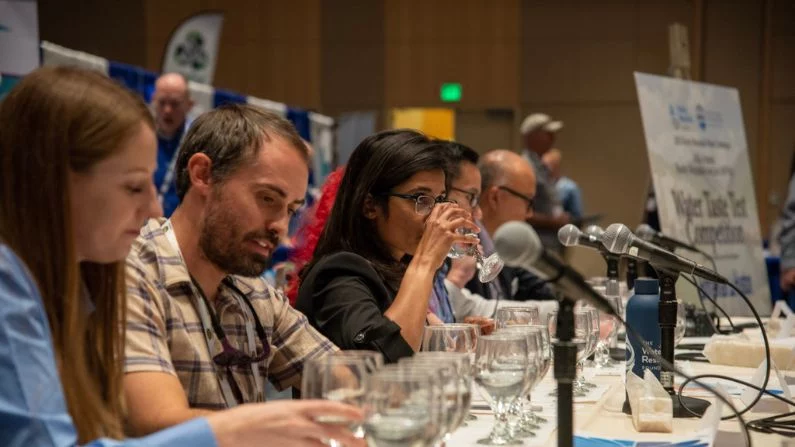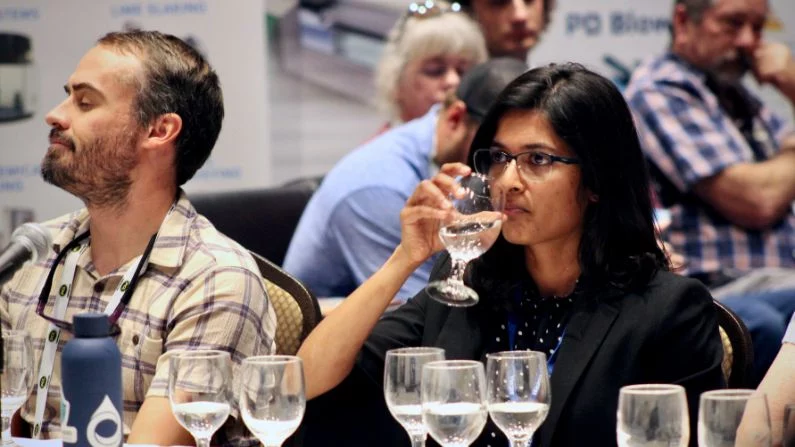Every time you turn on the tap, you become the last stop in a complicated journey.
Water from snow and streams collects in lakes and reservoirs, and cities pump it through complex filtration systems to make it pure enough to drink. The particular balance of invisible minerals in each pour from your kitchen tap makes for subtle differences in every glass. One might call it the terroir of tap water.
In a bustling hotel ballroom, surrounded by exhibition booths showing off the latest pipes, pumps and filters, a panel of judges gathered to spot those differences.
I was one of them.
The American Water Works Association assembled a panel of water wonks for its Rocky Mountain regional meeting in the ski resort town of Keystone. Here, we put tap water to the test, blind tasting samples from six cities across Colorado to crown a winner.
I’ll be honest, I don’t know a lick about water tasting. I’m an avid water enjoyer, that’s for sure. Just ask any waiter who’s made four or five return trips to top up my glass during dinner, or any of my friends who rarely see me without my liter Nalgene. I guzzle enough water to make a camel blush, but my taste buds aren’t nearly refined enough to spot the difference between water from Denver and Durango.
Fortunately, the panel was packed with experts. Besides myself, a reporter on the water beat, there were people who have made a career out of studying water taste and odor. One of them was Victor Sam, an engineer for the consulting firm Stantec.
I asked Sam some pre-competition advice: What was I even supposed to be looking for?
“Overall, you just want to have a pleasant experience,” he said. “Does it quench you? Does it taste good to you? Does it feel good? But, from a more scientific part of it, you can judge by mouthfeel. Is it slippery or is it grainy? Is it, maybe, dry? So it’s kind of like wine tasting.”

KUNC reporter Alex Hager interviews Victor Sam while judging the water taste test. “It’s kind of like wine tasting,” Sam said. (Ashley Waldron/City of Englewood Utilities)
The event organizers brought by a “taste and odor wheel,” a neatly charted list of all the tasting notes you might pick up from a glass of water. Of course, there was chlorine and bleach, but also a lot of the same terms you might hear on a Saturday afternoon in Napa Valley — fruity, grassy and earthy.
The wheel wasn’t much help for me and the judge seated to my right.
Colin Chung, a member of the American Water Works Association Board, is a celebrity around these parts. Even so, he’s neither a scientist nor a sommelier.
“I can’t tell the difference between a $10 bottle of wine and a $500 bottle of wine,” he said, with a chuckle. “They all taste good to me.”
While the tap water selection didn’t quite have the same depth and variety as wine, it was treated with the same ceremony and elegant touch as a nice cabernet.
The judges opened up heavy glass bottles brought to the competition by municipal water departments, decanting samples into stemmed glasses. Each judge received six pours, along with a grading sheet where we marked down scores from one to ten.
I delicately sipped a little from each glass. In the early stages, not much stood out. I could tell that one sample was different from another, but couldn’t exactly describe how. Sam, the taste and odor expert, said good-tasting water is typically laden with minerals.
“A lot of times if you actually drink pure water,” he explained, “it doesn’t taste good because what’s happening is you’re just drinking H2O — no minerals — and you’re essentially tasting your own tongue.”
Because of that, he said, bottled water companies will brag about added minerals that make their water taste more “quenching,” and less like your own tongue.

The panel of judges was given a “taste and odor wheel,” a neat list of tasting notes they might pick up from each sample. Flavors ranged from chemical — chlorine and bleach — to terms more commonly associated with wine: fruity, grassy and earthy. (Alex Hager/KUNC)
After a first pass at the six samples, it was time to take a second lap and jot down some scores. That’s no small feat when each tastes so bland. It was tough to cleanse my palate in between samples when the usual go-to palate cleanser is the very thing I’m supposed to be judging. The organizers put a few sleeves of Saltines on the table to help.
I took a few stabs at describing the taste of water in the comment section of my scoring sheet.
“Smooth, soft, airy.” That doesn’t say much, I realize, but they’re all positive remarks. So is “plain,” I suppose, and I used that label for Sample D.
The only one that received negative comments was Sample F, which I called “thin and rubbery.” Expert Sam agreed.
For some additional comfort from my non-expert neighbor, Chung, I asked if he was picking up on any of the nuances we saw highlighted in the taste and odor wheel.
“I’m trying and I’m trying to differentiate between the two,” he said. “And that’s very hard to do right now.”
But then, on my third or fourth sip from the Sample E glass, I had a breakthrough. Finally, a distinctive flavor: citrus. The faintest whisper of tangerine or grapefruit. Like, one tenth of a La Croix.
I ran the revelation past Sam, but his fine-tuned taste buds did not come to the same conclusion.
“I think that one gave me the most slipperiness,” he remarked. “Did you eat something sweet for lunch?”
Seeing as I hadn’t had a bite of anything besides Saltines since my breakfast burrito, I was elated that I’d picked up something so subtle that even my eagle-eyed (anteater-nosed? hummingbird-tongued?) neighbor couldn’t.
It was only a few minutes later when that jubilation came crashing down. Imagine my surprise when a routine key-check pat of my pockets revealed a forgotten tube of sweet mandarin ChapStick.

Organizers tally scores at an American Water Works Association regional meeting. Judges compared tap water samples from six different cities across Colorado. (Alex Hager/KUNC)
After seeing the rest of the judges turn in their score sheets, I scribbled down some shot-in-the-dark scores and turned in my sheet, dejectedly coming to terms with my newfound cluelessness when it comes to scrutinizing my favorite beverage. The organizers carefully tallied the votes and passed the findings along to the emcee.
Our winner? Grand Junction, Colorado.
The Western Slope community is a well-watered oasis in the desert. It’s the first decent-sized city you hit on the drive west from the mountains. Grand Junction’s city pipes are filled with melted snow before it has a chance to flow further south.
After the dust settled, I caught up with employees from the winning city’s water department, and they gave all the credit to their location.
“It comes straight from the Grand Mesa, the world’s largest flattop mountain,” said Amy Brown of Grand Junction’s water department. “Gorgeous place, great water, pristine snowmelt.”
At the end of the day, that could’ve been enough to make the difference. Judging water, or even just finding the particular brand or city tap that appeals to you, is far from an exact science. Just ask Susheera Pochiraju, one of the other judges. She’s an environmental engineer at the firm Hazen and Sawyer.. The emcee called her “Dr. Taste and Odor.”

Susheera Pochiraju has a PhD in water taste and odor, but said judging tap water isn’t an exact science. “I feel like taste and odor is really subjective to people,” she said. “People have differing opinions.” (Ashley Waldron/City of Englewood Utilities)
“I feel like taste and odor is really subjective to people,” she said. “People have differing opinions. Sitting right next to each other, me and my partners had different opinions. So I think it would be hard to come to a consensus.”
Pochiraju said you can be an effective judge of tap water even without any expertise.
“My point of view is that it shouldn’t have any significant flavor,” she said. “It should just taste clean and not dry your mouth. No one needs a Ph.D. All we need is to kind of calibrate ourselves.”
Next, Grand Junction will take its water to the American Water Works Association’s annual meeting in Toronto, where it’ll face off against the best tasting taps from all across the continent.
This story is part of ongoing coverage of water in the West, produced by KUNC, and supported by the Walton Family Foundation.






